Phone: (808) 585-3300 Fax: (808) 545-5063
Roman Catholic Church in the state of hawaii
Diocese of Honolulu
Witness to Jesus
About us

Help me find...
Most Reverend Larry Silva, Bishop of Honolulu
Most Reverend Larry Silva, Bishop of Honolulu
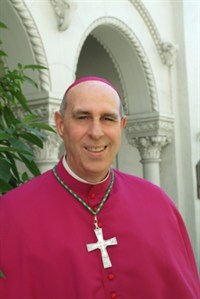
(2005-present) With Hawaiian family roots in Hawaii that extend back to the monarchy of King Kalakaua, Bishop Clarence "Larry" Silva was the Vicar General of the Diocese of Oakland when Pope Benedict XVI appointed him to be the fifth Bishop of Honolulu, since the establishment of the diocese in 1941 and the eleventh since missionaries brought the faith here in 1827.
Ordained a bishop and installed as Bishop of Honolulu on July 21, 2005 at the Neal Blaisdell Arena in Honolulu, Hawaii Catholics welcomed a man known to be a great priest, an experienced pastor, and a man of integrity. A parish priest for most of his ordained years, Bishop Silva came to inherit 66 island parishes, 28 mission churches and over 200,000 faithful.
Bishop Silva has engaged Hawaii's Catholics on a journey to accomplish a mission, a mission to give "Witness to Jesus." Not just an episcopal motto, "Witness to Jesus" has become the Road Map by which the diocese operates and fuels our infrastructure. He chose this motto, he said, because he is "convinced that our faith and our Church will be renewed to the extent that all our programs, structures and institutions can be more focused on the fact that Jesus Christ is not just a figure of past history, but is alive and active among us now. I want to be his witness and encourage others to witness to Him as well."
Bishop Silva's Bio
Bishop Silva's Staff and Contact Information
Past Bishops
 Bishop DiLorenzo (1993-2004)
Bishop DiLorenzo (1993-2004)
Philadelphia native Bishop Francis X. DiLorenzo was the auxiliary Bishop of Scranton when Pope John Paul II named him to be administrator of the Diocese of Honolulu immediately upon the retirement of Bishop Joseph A. Ferrario.
He served as administrator for a year before the pope appointed him as the fourth Bishop of Honolulu.
Installed on November 30, 1994, at the Co-Cathedral of St. Theresa, Bishop DiLorenzo introduced a diocese-wide parish renewal and review program called the "Welcoming Parish".
In June 2000, Bishop DiLorenzo convened the diocese's second synod to prepare the church in Hawaii for the 21st century through the drafting of 12 major proposals. Youth ministry and religious education were the top concerns of the synod delegates.
The bishop increased and strengthened the diocese's ministry to newly arrived immigrants, in particular Filipinos, Vietnamese, Samoans, Hispanics, Koreans, and Chinese.
During Bishop DiLorenzo's administration, the diocese joined a coalition to block the legalization by court mandate of same-sex marriage in Hawaii. The effort led to the adoption of a state constitutional amendment, which gave the power to ban same-sex marriage to the legislature.
Bishop DiLorenzo responded to the national sexual abuse scandal by heightening its response to victims, establishing a victim assistance program, publicizing its sexual misconduct policies and mandating safe environment training for all clergy and church and school employees.
After nearly 11 years in Hawaii, Bishop DiLorenzo was appointed by the Holy Father to be Bishop of Richmond, Virginia. He was installed in Richmond on May 24, 2004.
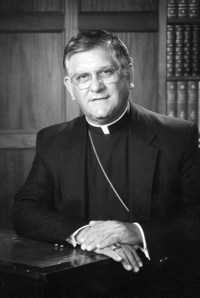 Bishop Ferrario (1982-1993)
Bishop Ferrario (1982-1993)
Born in Scranton, Pennsylvania., Bishop Joseph A. Ferrario came to Hawaii as a Sulpician priest to teach at St. Stephen's Seminary, a position he held for nine years.
He then joined the diocese, holding various administrative positions including the directorship of the Catholic Youth Organization. As head of CYO for five years, he helped recruit island teens and young adults to serve hundreds of disadvantaged children in camping and summer fun programs.
In 1978, after serving as pastor in two Oahu parishes, Father Ferrario was ordained auxiliary bishop to Bishop John J. Scanlan, succeeding him four years later in June 1982, as the third Bishop of Honolulu
Under the goals of "outreach, unity and renewal," Bishop Ferrario reorganized Catholic Charities, established the Office for Social Ministry and various ethnic ministries, encouraged parish renewal and actively promoted the concept of stewardship.
A strong supporter of liturgical renewal, Bishop Ferrario also established the Office of Worship and encouraged the updating of church interiors.
He established the Augustine Educational Foundation to provide tuition assistance for children in Catholic schools.
During his 11 years as bishop, he established two new Oahu parishes, Saint Jude in Makakilo and Resurrection of the Lord in Waipio. In 1985, he donated church land in Maui to establish transitional housing for Oahu's growing population of beach people.
Catholic Charities continued to pioneer progressive transitional shelters on three islands offering not only places for the homeless to live, but also vocational, medical and counseling services.
Bishop Ferrario retired on October 13, 1993 because of ill health. He died on December 12, 2003.
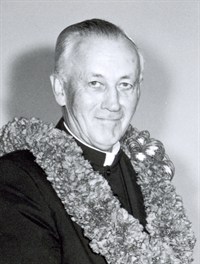 Bishop Scanlan (1967-1982)
Bishop Scanlan (1967-1982)
Born in County Cork, Ireland, in 1906, and serving San Francisco since his ordination in 1930, Bishop Scanlan was named auxiliary bishop of the Diocese of Honolulu in 1954. He attended sessions of the Second Vatican Council starting in 1962 until their completion in 1965.
In 1967, Pope Paul VI appointed him apostolic administrator of the diocese when illness forced Bishop Sweeney to retire. Upon Bishop Sweeney's death the next year, Bishop Scanlan was named the second Bishop of Honolulu.
As bishop, he created four new parishes in Hawaii and built nine churches. He welcomed Hawaii's increasingly diversified ethnic mix by establishing Masses in different parishes in Korean, Filipino dialects and Vietnamese, and also helped to establish a Samoan Catholic Council.
Bishop Scanlan was responsible for inviting nine new religious communities to serve in the diocese in schools, hospitals, outreach and the contemplative life.
Bishop Scanlan led a public demonstration in the rotunda of the State Capitol in 1970 against a proposed abortion bill, and after the bill became law was an outspoken proponent for the respect and reverence of life. As a response to the abortion issue, he opened the Mary Jane Home for unwed mothers and their babies, inviting the Sisters of the Good Shepherd to Hawaii to operate the facility in 1976.
In 1981, he ordained the diocese's first class of permanent deacons.
Bishop Scanlan retired at the mandatory age of 75 in 1981, remaining as apostolic administrator of the diocese until Bishop Joseph A. Ferrario, auxiliary since 1978, was appointed bishop in 1982. Bishop Scanlon died on January 31, 1997.
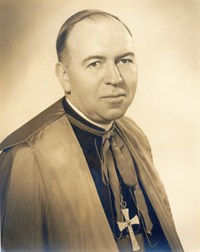 Bishop Sweeney (1941-1967)
Bishop Sweeney (1941-1967)
Pope Pius XII, on May 20, 1941, named Father James J. Sweeney of San Francisco as the first bishop of the newly established Diocese of Honolulu. He was 42.
Bishop Sweeney's appointment occurred seven months before the bombing of Pearl Harbor by the Japanese. During the war, he organized a Crusade of Prayer, by which the children of the diocese each adopted one of the many servicemen who flooded the islands and prayed for him and his safety. The bishop confirmed nearly 400 troops during this time, visited hospitals, and worked with the Sisters of St. Francis to expand St. Francis Hospital to improve medical facilities for the civilian population.
Catholic education blossomed under Bishop Sweeny. When he was appointed in 1941, there were 19 Catholic schools, by his 25th anniversary as bishop; the diocese had two seminaries (one diocesan, and one of the Sacred Hearts Congregation), 10 Catholic high schools and 30 elementary schools with 17,150 students enrolled.
Bishop Sweeney also established the Confraternity of Christian Doctrine (CCD) to teach the faith to children attending non-Catholic schools. By 1966, there were 22,613 students in religious instruction classes from the public schools.
Bishop Sweeney also created many new parishes: ten on Oahu, six on the Big Island, three on Maui, one on Lanai, two on Kauai, and one on Molokai.
To increase the number of priests for the diocese, Bishop Sweeney purchased the Harold Castle home in Kaneohe and turned it into St. Stephen's Seminary in May 1946.
He built up the diocese's Catholic Social Service, reorganized Catholic Charities in 1943, and again revamped it in 1948.
With his auxiliary Bishop John J. Scanlan, Bishop Sweeney also attended the first session of the Second Vatican Council 1962. Bishop Sweeney retired and soon after passed to his eternal reward on June 19, 1968.
Our Bishops of the Missionary Period
During its missionary period, 1827-1940, the Catholic Church in Hawaii had six bishops, called vicars apostolic. The all belonged to the France-based Congregation of the Sacred Hearts, which sent the first Catholic missionaries to Hawaii in 1827.
 Bishop Alencastre (1926-1940)
Bishop Alencastre (1926-1940)
Born of Portuguese parents in Porto Santo, on the Portuguese island of Madeira, the future Bishop Stephen Alencastre, SS.CC. migrated to Hawaii with his family when he was just an infant, living on Hawaii, Kauai and later on Maui.
Desiring to be a priest, he was sent to Europe for his seminary studies. He was ordained a priest at the Fort Street cathedral on April 5, 1902. In 1913, he was assigned to the Punahou mission in Honolulu and the following year constructed the present Sacred Heart Church on Wilder Avenue as its pastor.
On April 29, 1924, Father Alencastre became a coadjutor bishop to the sickly Bishop Boeynaems, succeeding him upon his death in 1926.
The new bishop, Hawaii's sixth and last vicar apostolic, realized the changing times and saw the need for training island men for the priesthood. He opened the first St. Stephen's Seminary in Kalihi Valley. Bishop Alencastre also did some major renovation to the cathedral, importing the marble main altar to coincide with the 100th anniversary of the Catholic Faith in Hawaii in 1927.
Alencastre was also responsible for the continual building of schools and churches in the islands. On November 11, 1940 Bishop Alencastre died of illness on board a passenger ship returning to Hawaii from Los Angeles. With his passing, the mission era of the Catholic Church in Hawaii came to an end.
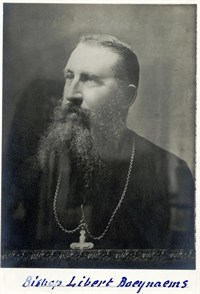 Bishop Boeynaems (1903 - 1926)
Bishop Boeynaems (1903 - 1926)
Bishop Libert Boeynaems, SS.CC. came from Belgium to Hawaii in 1881 and spent his first fourteen years on the island of Kauai before being assigned to Wailuku, Maui.
Appointed bishop on July 25, 1903, he initiated many building projects throughout the mission. Three major churches were built during his term of office: Sacred Heart Church, Punahou (1914) St. Joseph Church, Hilo (1919), and the renovation of St. Anthony in Wailuku (1920)
Also part of the Sacred Heart Father's building program were St. Anthony's Orphanage in Kalihi Valley (1909), St. Anthony's Orphanage, Wailuku (1923), and Father Louis Boys' Home, Hilo (1916).
Bishop Boeynaems ambitious plan to convert the Fort Street cathedral into an impressive Gothic structure began with the construction in 1910 of an ornate Gothic porch fronting the church as a first phase of his proposed plan to renovate the church.
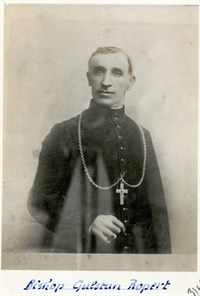 Bishop Ropert (1892-1903)
Bishop Ropert (1892-1903)
Father Gulstan Ropert, SS.CC. came to Hawaii from France in 1868 and was assigned to Hamakua on the Big Island, where he immediately fell in love with the Hawaiian people. He made Waipio Valley his center and had Father Damien, his neighbor in Kohala, build a couple of chapels there.
After fifteen years in Hamakua and nine years in Wailuku, Maui, he was appointed bishop, despite his protests, on September 25, 1892. He continued his predecessor's support of education by building Catholic schools. and assisted the Franciscan Sisters with their hospital in Kalaupapa.
In December, 1892, Bishop Ropert constructed an impressive two-story residence for the mission fathers on the cathedral grounds and erected the statue of Our Lady of Peace that still stands in the cathedral courtyard.
Bishop Ropert's administration witnessed the overthrow of the Hawaiian monarchy and the eventual annexation of Hawaii by the United States. The bishop was a good administrator, mild-mannered, and extremely kind and patient. Many say that his disposition suited well the quiet conducting of the affairs of the Catholic mission through Hawaii's disturbing political era.
After patiently bearing an illness for several years, Bishop Ropert died on January 4, 1903. He is buried next to Bishop Koeckemann at the King Street Cemetery.
 Bishop Koeckemann (1882-1892)
Bishop Koeckemann (1882-1892)
German-born Bishop Herman Koeckemann, SS.CC. was a brilliant scholar. He arrived in Hawaii in 1854 as a young priest and was assigned continually to the Honolulu mission. He was made coadjutor bishop, one designated to follow the present bishop, on August 21, 1881, to assist the aging Bishop Louis Maigret.
Bishop Koeckemann became Hawaii's third vicar apostolic following Maigret's death nearly a year later. With a diminishing population of the native Hawaiians, his administration saw a new apostolate with the growing numbers of Portuguese immigrants. A strong advocate of education, he introduced the Marianist Brothers to staff Catholic boys' schools in Honolulu, Wailuku and Hilo. He welcomed then Mother Marianne Cope and her Franciscan Sisters of Syracuse to work with Hansen's disease patients in Honolulu and Molokai.
The bishop's relationship with Father Damien was stormy at times, but he always showed a fatherly concern for the great "Apostle of Molokai."
Bishop Koeckemann died shortly after being stricken with paralysis on February 22, 1892. He was finally laid to rest under the tall iron cross in the Catholic cemetery on King Street near downtown Honolulu.
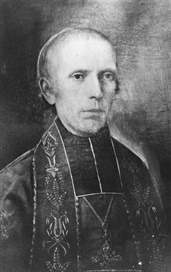 Bishop Maigret (1847-1882)
Bishop Maigret (1847-1882)
A French Sacred Hearts priest who worked with Bishop Rouchouze in Gambier and Hawaii, Father Louis Maigret, SS.CC. was exiled from Hawaii in 1837, along with the dying Sacred Hearts Father Alexis Bachelot. They left Honolulu bound for Ponape on November 23, 1837. During the voyage, Father Bachelot, Hawaii's first Catholic priest, passed away and was buried in Ponape by Fr. Maigret.
Made a bishop in 1847, Bishop Maigret completed the cathedral planned by his predecessor in 1843; founded the island's first Catholic school, Ahuimanu, in 1846; and brought in Hawaii's first nuns, the Sacred Hearts Sisters, in 1859.
Bishop Maigret ordained Father Damien de Veuster in the Honolulu cathedral on May 21, 1864, and in 1873 assigned him to Molokai. In late 1869, he attended the First Vatican Council in Rome.
Bishop Maigret died on June 11, 1882, after 42 years of service in Hawaii, 35 of those years as a bishop. He is buried in a crypt below the cathedral sanctuary.
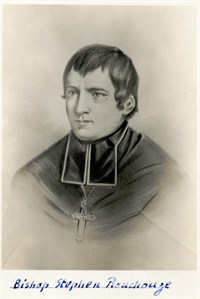 Bishop Rouchouze (1833-1843)
Bishop Rouchouze (1833-1843)
Hawaii's first missionary bishop, Stephen Rouchouze SS.CC. was a Frenchman. He was consecrated a bishop in 1833 at the young age of 35 to head the mission of "Eastern Oceania" which included the islands of Hawaii, Tahiti, Gambier, Marquesas and Tuamotu. He was stationed in Gambier in 1835, and after religious freedom was permitted in Hawaii, arrived here on May 15, 1840.
On June 6, the eve of Pentecost, he baptized 195 native Hawaiians at the Honolulu mission on Fort Street, signed a contract on June 22 for the building of the Cathedral of Our Lady of Peace; and in December ordained Sacred Hearts Father Bernabe Castan to the priesthood, the first ordination in Hawaii.
Bishop Rouchouze sailed for Europe on January 3, 1841, to gather more missionaries and supplies for his Pacific missions. But on his return voyage in early 1843, his ship, the "Marie-Joseph" sank and all were lost at sea.
